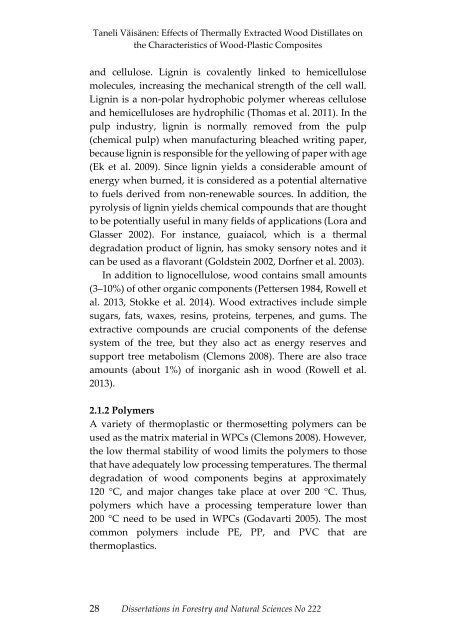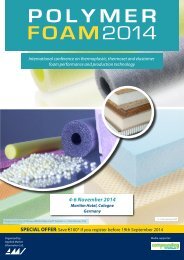Dissertations in Forestry and Natural Sciences
24lYKFN
24lYKFN
Create successful ePaper yourself
Turn your PDF publications into a flip-book with our unique Google optimized e-Paper software.
Taneli Väisänen: Effects of Thermally Extracted Wood Distillates on<br />
the Characteristics of Wood-Plastic Composites<br />
<strong>and</strong> cellulose. Lign<strong>in</strong> is covalently l<strong>in</strong>ked to hemicellulose<br />
molecules, <strong>in</strong>creas<strong>in</strong>g the mechanical strength of the cell wall.<br />
Lign<strong>in</strong> is a non-polar hydrophobic polymer whereas cellulose<br />
<strong>and</strong> hemicelluloses are hydrophilic (Thomas et al. 2011). In the<br />
pulp <strong>in</strong>dustry, lign<strong>in</strong> is normally removed from the pulp<br />
(chemical pulp) when manufactur<strong>in</strong>g bleached writ<strong>in</strong>g paper,<br />
because lign<strong>in</strong> is responsible for the yellow<strong>in</strong>g of paper with age<br />
(Ek et al. 2009). S<strong>in</strong>ce lign<strong>in</strong> yields a considerable amount of<br />
energy when burned, it is considered as a potential alternative<br />
to fuels derived from non-renewable sources. In addition, the<br />
pyrolysis of lign<strong>in</strong> yields chemical compounds that are thought<br />
to be potentially useful <strong>in</strong> many fields of applications (Lora <strong>and</strong><br />
Glasser 2002). For <strong>in</strong>stance, guaiacol, which is a thermal<br />
degradation product of lign<strong>in</strong>, has smoky sensory notes <strong>and</strong> it<br />
can be used as a flavorant (Goldste<strong>in</strong> 2002, Dorfner et al. 2003).<br />
In addition to lignocellulose, wood conta<strong>in</strong>s small amounts<br />
(3–10%) of other organic components (Pettersen 1984, Rowell et<br />
al. 2013, Stokke et al. 2014). Wood extractives <strong>in</strong>clude simple<br />
sugars, fats, waxes, res<strong>in</strong>s, prote<strong>in</strong>s, terpenes, <strong>and</strong> gums. The<br />
extractive compounds are crucial components of the defense<br />
system of the tree, but they also act as energy reserves <strong>and</strong><br />
support tree metabolism (Clemons 2008). There are also trace<br />
amounts (about 1%) of <strong>in</strong>organic ash <strong>in</strong> wood (Rowell et al.<br />
2013).<br />
2.1.2 Polymers<br />
A variety of thermoplastic or thermosett<strong>in</strong>g polymers can be<br />
used as the matrix material <strong>in</strong> WPCs (Clemons 2008). However,<br />
the low thermal stability of wood limits the polymers to those<br />
that have adequately low process<strong>in</strong>g temperatures. The thermal<br />
degradation of wood components beg<strong>in</strong>s at approximately<br />
120 °C, <strong>and</strong> major changes take place at over 200 °C. Thus,<br />
polymers which have a process<strong>in</strong>g temperature lower than<br />
200 °C need to be used <strong>in</strong> WPCs (Godavarti 2005). The most<br />
common polymers <strong>in</strong>clude PE, PP, <strong>and</strong> PVC that are<br />
thermoplastics.<br />
28 <strong>Dissertations</strong> <strong>in</strong> <strong>Forestry</strong> <strong>and</strong> <strong>Natural</strong> <strong>Sciences</strong> No 222



